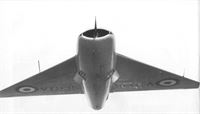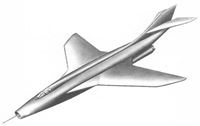
Описание
Страна : Великобритания
Год : 1950
Одноместный околозвуковой экспериментальный самолет
Boulton Paul P.111 и P.120
Экспериментальные самолеты Р.111 и Р.120 собрали по спецификациям Е.27/46 и Е.27/49 для исследования характеристик треугольного крыла.
Р.111 впервые взлетел 10 октября 1950 года с турбореактивным двигателем Rolls-Royce Nene RN.2 Mk 3. Самолет создавался по аэродинамической схеме "бесхвостка", законцовки консолей крыла были сделаны съемными. После испытаний машины в первоначальном виде ее оснастили носовой штангой с датчиками и четырьмя прямоугольными аэродинамическими тормозами по периметру носовой части фюзеляжа. Также ввели некоторые другие изменения. В новом виде машина получила обозначение Р.111A. Ее летные испытания возобновили в июле 1953 года. Считается, что Р.111A мог превысить скорость звука в пологом пикировании. Р.120 впервые взлетел 6 августа 1952 года. По компоновке он был подобен Р.111, но имел цельноповоротный хвостовой стабилизатор. К сожалению, 29 августа он разбился в аварии, возможная причина которой - флаттер хвостового оперения. Р.120 стал последним самолетом, разработанным и собранным на фирме "Boulton Paul".
ТАКТИКО-ТЕХНИЧЕСКИЕ ХАРАКТЕРИСТИКИ
Boulton Paul Р.111A
Тип: одноместный околозвуковой экспериментальный самолет
Силовая установка: турбореактивный двигатель Rolls-Royce Nene RN.2 Mk 3 тягой 22,69 кН
Летные характеристики: максимальная скорость 0.98М; начальная скороподъемность 2865 м/мин
Масса: пустого самолета 2948 кг; максимальная взлетная 4354 кг
Размеры: (крыло с заостренными законцовками) размах крыла 10,21 м; длина 7,95 м; высота 3,81 м; площадь крыла 26,95 м2
- Описание
Фотографии
-
Aeroplane Monthly 1996-08 / 1996 UK Aircraft Collections and Museums Guide (2)
Регистрационный номер: VT935 [16] Two of the more unusual exhibits at the Midland Air Museum, Coventry Airport, are Boulton Paul P.111A experimental delta VT935 and, looming in the background, Armstrong Whitworth Argosy G-APRL.
Другие самолёты на фотографии: Armstrong Whitworth Argosy / A.W.650 - Великобритания - 1959
-
Мировая Авиация 71
Регистрационный номер: VT935 [16] Треугольное крыло Р.111 имело угол стреловидности по передней кромке 45". Возможность замены законцовок крыла упростила их сравнительный анализ. Размах крыла самолета с законцовками как на снимке уменьшался до 7,82 м, а площадь - до 25,01 м2, по сравнению с заостренными законцовками.
-
Aeroplane Monthly 2000-01 / M.Hooks - Ben Gunn 1929-1999 /Obituary/
Регистрационный номер: VT935 [16] Benn Gunn flying the Boulton Paul P.111, which he demonstrated at Farnborough shows in 1951 and 1953.
-
Aeroplane Monthly 1993-02 / B.Jones - Boulton Paul's dicey deltas /British post-war experimental jet aircraft/ (6)
Регистрационный номер: VT935 [16] VT935 in its original unadorned silver colour scheme.
-
Air Enthusiast 2003-11 / A.Brew - Proud heritage
Регистрационный номер: VT935 [16] The sole Boulton Paul P. 111, VT 935 was contracted in November 1946 under Specification E.27146 to research delta wing handling at high speed and first flew some three years, nine months later, on 6 October 1950. The P.111's sole stable-mate, the P. 120, VT 951 employed the same basic wing and fuselage, but carried a much modified fin and rudder, to which had been added an all-flying, or slab tailplane mounted two-thirds up the fin. The P.120 first went aloft early in August 1952. Quite what these machines were envisaged to achieve with the relatively modest 5.100lb s.t of their single Rolls-Royce Nenes begs a host of questions. The highest speed known to have been reached by the P.111 in level flight was Mach 0.935 at 35.000 feet, or 622mph, during 1953 trials. (Boulton Paul)
-
Aeroplane Monthly 1993-07 / Skywriters
Регистрационный номер: VT935 [16] The yellow-and-black Boulton Paul P.111A VT935 pictured in September 1953.
-
Aeroplane Monthly 1993-02 / B.Jones - Boulton Paul's dicey deltas /British post-war experimental jet aircraft/ (6)
Регистрационный номер: VT935 [16] VT935 as the P.111a, in an overall yellow colour scheme with a black cheatline running from the intake to the mid-span wing leading edge. By this time it had a set of four airbrakes fitted to reduce its fearsome landing speed.
-
Aeroplane Monthly 1993-02 / B.Jones - Boulton Paul's dicey deltas /British post-war experimental jet aircraft/ (6)
Регистрационный номер: VT935 [16] View of the Boulton Paul P.111/111a prototype VT935, showing its compact delta planform and distinctive flattened elliptical intake. The aircraft is seen with airbrakes open
-
Aeroplane Monthly 1993-02 / B.Jones - Boulton Paul's dicey deltas /British post-war experimental jet aircraft/ (6)
Регистрационный номер: VT935 [16] View of the P.111 prototype VT935, which made its maiden flight in the hands of Boulton Paul chief test pilot A. E. "Benn" Gunn at A&AEE Boscombe Down on October 10, 1950.
-
Aeroplane Monthly 1993-02 / B.Jones - Boulton Paul's dicey deltas /British post-war experimental jet aircraft/ (6)
Регистрационный номер: VT935 [16] View of the Boulton Paul P.111/111a prototype VT935, showing its compact delta planform and distinctive flattened elliptical intake. The aircraft is seen taxying at the 1951 Farnborough Air Display.
-
Air Enthusiast 1997-05 / T.Buttler - Early Wing-Swingers
Регистрационный номер: VT935 [16] Boulton Paul P.111A VT935, the squat fuselage and centre-body mounted pitot tube reflecting the P.121 project.
-
Jane's All the World Aircraft 1980 / Encyclopedia of Aviation - Aircraft A-Z - v2
Регистрационный номер: VT935 [16] Boulton Paul P.111.
-
Aeroplane Monthly 1998-10 / Personal album. Military
Регистрационный номер: VT935 [16] Built to specification E.27/46 for research into delta-wing aerodynamics, the Boulton Paul P.111 VT935 had a Rolls-Royce Nene engine. Chief test pilot Ben Gunn undertook taxying trials on Pendeford’s grass runway on May 5, 1950, but the first flight took place at Boscombe Down. The little delta is preserved at the Midland Air Museum, Coventry.
-
Aeroplane Monthly 1993-02 / B.Jones - Boulton Paul's dicey deltas /British post-war experimental jet aircraft/ (6)
Регистрационный номер: VT935 [16] View of the P.111 prototype VT935, which made its maiden flight in the hands of Boulton Paul chief test pilot A. E. "Benn" Gunn at A&AEE Boscombe Down on October 10, 1950. The characteristic nose-up ground attitude of the aircraft is apparent in this picture, as is the tall pointed fin - the extreme tip of which was designed to be removable for inflight comparison of sharp and blunt tip profiles.
-
Мировая Авиация 125
Регистрационный номер: VT935 [16] 10 октября 1950г.: экспериментальный самолет Boulton Paul P.111 выполнил первый полет в Боскомб-Дауне под управлением Бена Ганна, позже он доработан в P.111A.
-
Aeroplane Monthly 1993-02 / B.Jones - Boulton Paul's dicey deltas /British post-war experimental jet aircraft/ (6)
Регистрационный номер: VT935 [16] Three views illustrating the P.111’s stages of wingtip expansion; they increased the span from the basic 25ft 8in (left) to 29ft 8in, and ultimately to 33ft 6in.
-
OS 1 / H.Cowin - X-Planes
Регистрационный номер: VT951 [5] The short-lived Boulton Paul P. 120, first flown on 6 August 1952, ended spectacularly a little over three weeks later, on the 29th. The highest speed known to have been reached by the P. 120 was Mach 0.68 at 4.000 feet, or 518mph, moments before it lost its left-side elevon. Fortunately, Boulton Paul's Chief Test Pilot, A.E. 'Ben' Gunn ejected successfully, going on to end his career in airport management.
-
Aeroplane Monthly 1993-02 / B.Jones - Boulton Paul's dicey deltas /British post-war experimental jet aircraft/ (6)
Регистрационный номер: VT951 [5] The P.120 as originally rolled out at Pendeford in July 1952, in natural metal finish.
-
OS 1 / H.Cowin - X-Planes
Регистрационный номер: VT951 [5] 6 августа 1952г.: построенный для изучения аэродинамики дельтовидного крыла и оснащенный двигателем Nene, самолет Boulton Paul P.120 разбился 28 августа, налетав всего 11 часов.
The sole Boulton Paul P. 120 had one of the shortest flying careers of all, even for a research aircraft. The second of two Boulton Paul P.111 research machines, VT951 became the P. 120 when it was decided to equip the aircraft with a revised fin and rudder to which a 'slab', or all-flying tailplane was attached. -
Air Enthusiast 2003-11 / A.Brew - Proud heritage
Регистрационный номер: VT951 [5] P.120 VT951 made only two flights in the final paint scheme.
-
Aeroplane Monthly 1993-02 / B.Jones - Boulton Paul's dicey deltas /British post-war experimental jet aircraft/ (6)
Регистрационный номер: VT951 [5] VT951, the P.120, was designed to investigate the interaction between a delta wing and a horizontal tailplane. It was painted in the colours seen here - gloss black with a yellow cheatline - in order to steal the 1952 Farnborough Show limelight from Avro’s blue and vermilion pair of 707 research deltas.
-
Air Enthusiast 1997-05 / T.Buttler - Early Wing-Swingers
Artist’s impression of the P.121.
-
Aeroplane Monthly 1993-02 / B.Jones - Boulton Paul's dicey deltas /British post-war experimental jet aircraft/ (6)
Boulton Paul P.111, P.111a & P.120
-
Air Enthusiast 2003-11 / A.Brew - Proud heritage
Boulton Paul BP.120.
-
Air Enthusiast 1997-05 / T.Buttler - Early Wing-Swingers
Boulton Paul P.121 project.
- Фотографии
























